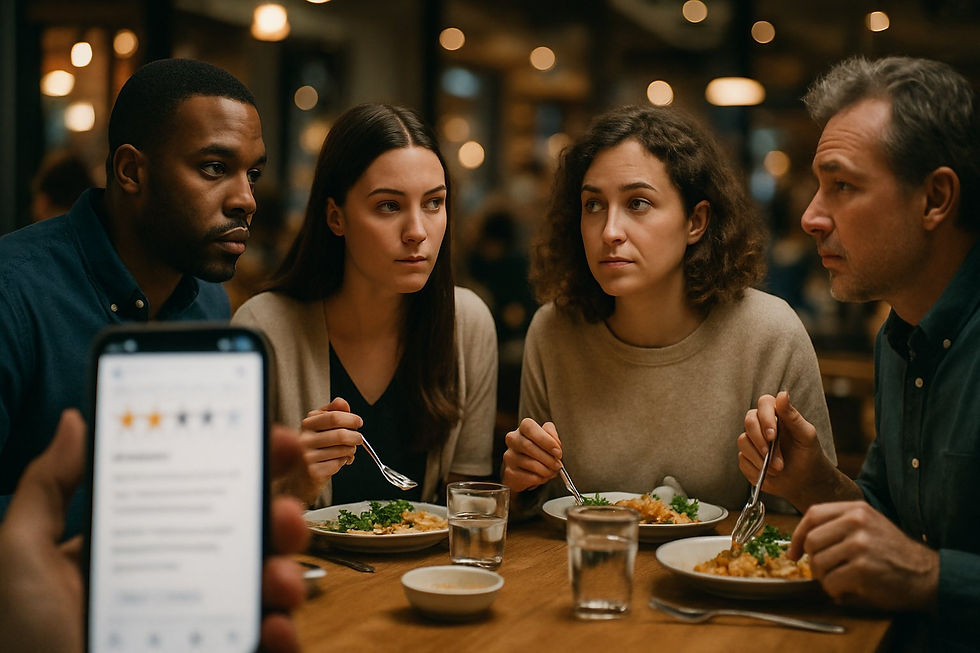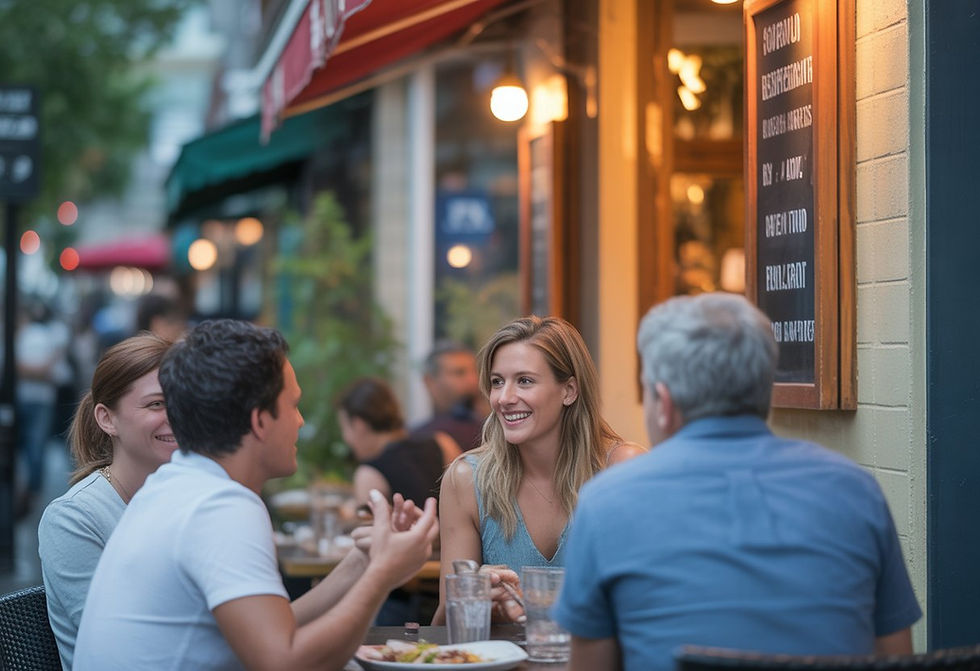Are Online Restaurant Reviews Fake?
- AWOL Greg

- Nov 11
- 6 min read
You've probably wondered if the glowing five-star review for that new restaurant down the street is genuine or if someone paid to write it. The short answer is troubling: fake restaurant reviews are widespread, with research showing that up to 16% of restaurant reviews on major platforms are fraudulent. This means roughly one in six reviews you read might be completely made up.

The problem is bigger than most of us realise. Fake reviews cost consumers £300 billion annually, and criminals are even blackmailing restaurant owners by threatening to flood their listings with fake one-star reviews. What's particularly concerning is that consumers can only identify fake reviews about 4% of the time.
Understanding how to spot these fraudulent reviews has become essential for making informed dining decisions. We'll explore the scale of this problem, examine which platforms are most affected, and give you practical tools to identify genuine reviews from the fakes.
Key Takeaways
Approximately 16% of restaurant reviews on major platforms are fake, costing consumers billions annually
Google has the highest rate of fake reviews at 10.7%, compared to Yelp's 7.1% and TripAdvisor's 5.2%
Most consumers can only identify fake reviews 4% of the time, making it crucial to learn proper detection techniques
Are Most Reviews Fake?
Most restaurant reviews are genuine, but fake ones are a real problem. Research shows that 23% of reviews are suspected to be fake, which means roughly 1 in 4 reviews might not be trustworthy.
The data reveals an interesting breakdown:
Review Type | Percentage |
Genuine reviews | 53% |
Poorly written reviews | 24% |
Suspected fake reviews | 23% |
Up to 15% of restaurant reviews specifically are fraudulent. This means fake restaurant reviews affect millions of dining decisions every day.
Fake reviews come in different forms:
Overly positive reviews written by restaurant owners
Extremely negative reviews from competitors
Generic reviews with no specific details
Reviews posted in suspicious patterns
We see that poorly written reviews make up another 24% of all reviews. These aren't necessarily fake, but they provide little useful information for diners.
The good news is that genuine reviews still make up the majority at 53%. However, with nearly half of all reviews being either fake or poorly written, we need to be careful when reading restaurant reviews online.
Scammers actively target people to write fake positive reviews in exchange for money, making this an ongoing problem for the restaurant industry.
How Big Is The Fake Review Problem?
The fake review problem has reached massive proportions across the internet. 30% of all online reviews are fake, meaning nearly one in three reviews we read could be deliberately misleading.

The numbers are even more alarming when we look deeper. Research shows that 47% of reviews on major websites are identified as suspicious, highlighting how widespread this deception has become.
Consumer exposure is widespread:
82% of consumers encounter fake reviews at least once per year
92% of 18-34 year olds have seen fake reviews
Only 59% of consumers aged 55 and older report encountering them
Platform-Specific Fake Review Rates
Different platforms face varying levels of fake review problems:
Platform | Fake Review Rate |
10.7% | |
Yelp | 7.1% |
TripAdvisor | 5.2% |
4.9% |
The financial impact is staggering. Fake reviews cost consumers £787 billion in 2025 due to misleading purchases.
Fake positive reviews can boost sales by 12.5% in the first two weeks. A single fraudulent extra star can raise demand by 38%.
Restaurant owners are particularly vulnerable. Criminals target restaurant owners with blackmail, threatening to flood their listings with fake one-star reviews unless they pay.
This problem continues growing as AI-generated reviews increase 80% month-over-month since 2023.
How Is AWOL Fixing It
AWOL is a British startup that tackles fake reviews through a simple but effective approach. The company requires proof of visit before users can submit reviews, creating a barrier that stops fake feedback entirely.
This verification system ensures only real customers can leave reviews. Unlike traditional review platforms, AWOL checks that people actually visited the restaurant before allowing them to share their experience.
The app works differently from major review platforms by focusing on verified reviews only. Users must prove they dined at a restaurant before writing about it.
This eliminates the common problem of fake positive and negative reviews that plague other sites.
AWOL offers additional features that benefit both diners and restaurants:
Smart taste matching that learns user preferences
Exclusive deals and discounts from participating venues
Instant table booking capabilities
Daily raffle rewards for app users
The platform positions itself as built for people sick of fake reviews, rigged rankings, and paying to be seen. It promises to give real users genuine recommendations whilst offering venues fair access to customers.
By removing ads and algorithms, AWOL aims to create a more trustworthy alternative to existing review platforms. The startup's approach addresses the core problem that allows fake reviews to flourish on other sites.
Frequently Asked Questions
Understanding fake restaurant reviews requires knowledge of detection methods, platform policies, and legal frameworks. These common questions address how consumers, restaurants, and regulatory bodies handle fraudulent reviews.
How can consumers spot fraudulent reviews on restaurant platforms?
We can identify fake reviews by looking for several warning signs. Generic language without specific details about food or service often indicates fraudulent content.
Reviews posted in clusters within short timeframes suggest coordinated fake activity. Extreme language patterns and overly positive or negative tones without balanced feedback raise red flags.
Profile analysis reveals important clues. New accounts with limited review history or profiles lacking personal information frequently post fake content.
We should examine reviewer behaviour patterns. Users who only review similar businesses or post multiple reviews for the same restaurant likely create fraudulent content.
What measures do online platforms take to ensure the authenticity of restaurant critiques?
Most platforms employ automated detection systems to identify suspicious review patterns. These systems analyse posting frequency, language patterns, and account behaviour.
Google and similar platforms have policies against fake reviews. They remove content when evidence proves reviews are misleading or false.
Verification processes help authenticate genuine customers. Some platforms require proof of visit or purchase before allowing reviews.
We see platforms using machine learning to detect coordinated fake review campaigns. They monitor for unusual spikes in reviews or similar language across multiple posts.
To what extent do fabricated critiques impact a restaurant's reputation?
Fake reviews significantly damage restaurant reputations and customer trust. Negative fabricated reviews can reduce bookings and revenue substantially.
Research shows between 11-15% of reviews on major platforms are fake. This high percentage affects how customers make dining decisions.
Restaurants lose competitive advantage when competitors post false negative reviews. Positive fake reviews create unrealistic expectations that lead to disappointed customers.
Recovery from fake review damage requires active reputation management. Restaurants must monitor their online presence and respond professionally to all feedback.
What are the legal consequences of posting deceptive reviews for eateries online?
The UK has strict consumer protection laws regarding false advertising and misleading reviews. Businesses face legal action for posting fake content.
We can report competitors who post false reviews to the Competition and Markets Authority. The CMA investigates businesses that violate consumer protection regulations.
Legal action serves as a last resort when other methods fail. Courts can order removal of false reviews and award damages.
Individuals posting fake reviews may face defamation claims. Restaurants can pursue compensation for proven business losses from fraudulent reviews.
How do genuine patrons distinguish their feedback from deceptive endorsements?
Authentic reviewers include specific details about their dining experience. We mention particular dishes, service interactions, and restaurant atmosphere.
Genuine reviews show balanced perspectives with both positive and negative aspects. Real customers rarely give exclusively five-star or one-star ratings without explanation.
Honest reviewers post photos of actual meals and restaurant interiors. These images provide evidence of genuine visits.
We write reviews at natural intervals after dining experiences. Authentic feedback appears days or weeks after visits, not immediately in bulk.
What role do regulatory bodies play in monitoring and addressing fake online reviews for restaurants?
The Competition and Markets Authority oversees consumer protection laws related to fake reviews. The CMA investigates businesses that violate regulations about misleading customer feedback.
Trading Standards officers can prosecute businesses for posting false reviews. These authorities have power to fine companies and pursue criminal charges.
Regulatory bodies work with platforms to improve fake review detection. They provide guidance on compliance with consumer protection laws.
We see increased enforcement against fake review schemes. Authorities are taking stronger action against businesses that manipulate online ratings through fraudulent means.




Comments